Search Result
Results for "
N-methyl-D-aspartate (NMDA)
" in MedChemExpress (MCE) Product Catalog:
9
Isotope-Labeled Compounds
| Cat. No. |
Product Name |
Target |
Research Areas |
Chemical Structure |
-
- HY-100807
-
|
|
|
|
|
Quinolinic acid is an endogenous N-methyl-D-aspartate (NMDA) receptor agonist synthesized from L-tryptophan via the kynurenine pathway and thereby has the potential of mediating N-methyl-D-aspartate neuronal damage and dysfunction .
|
-
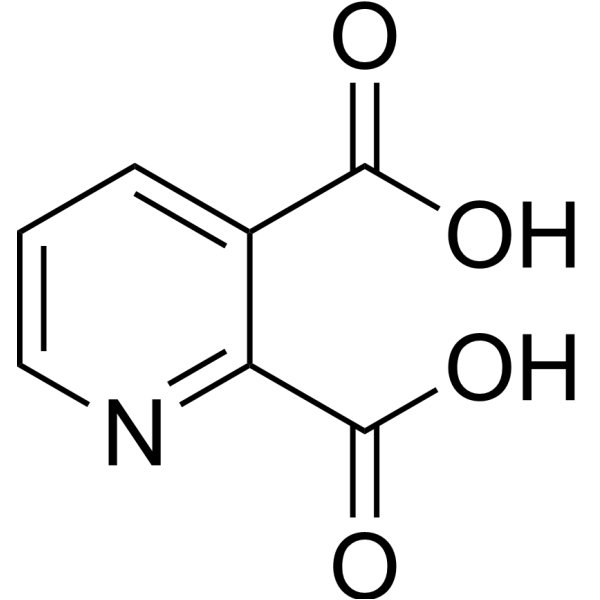
-
- HY-100807S
-
|
|
Endogenous Metabolite
iGluR
|
Neurological Disease
Inflammation/Immunology
|
|
Quinolinic acid-d3 is the deuterium labeled Quinolinic acid. Quinolinic acid is an endogenous N-methyl-D-aspartate (NMDA) receptor agonist synthesized from L-tryptophan via the kynurenine pathway and thereby has the potential of mediating N-methyl-D-aspartate neuronal damage and dysfunction[1][2].
|
-
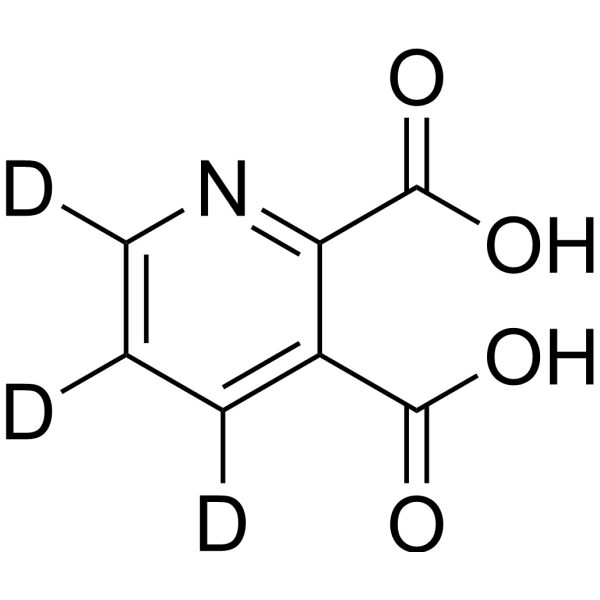
-
- HY-W001601
-
|
|
iGluR
|
Neurological Disease
|
|
Budipine is an anti-parkinson agent. Budipine also is a substrate of P-glycoprotein (P-gp), is mediated the uptake into the brain by P-gp. Budipine also is N-methyl-d-aspartate (NMDA) antagonist, and has indirect dopaminergic effects through an improved dopamine release, the inhibition of monoamine oxidase type B (MAO-B). Budipine can be used for the research of CNS disorders include Parkinson disease .
|
-
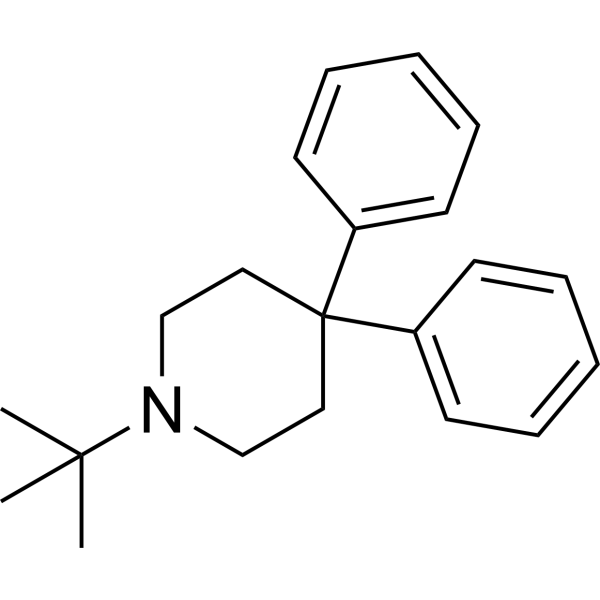
-
- HY-P1287
-
|
|
iGluR
|
Neurological Disease
|
|
Conantokin-T is a γ-carboxyglutamate-containing, N-methyl-D-aspartate (NMDA) antagonist peptidewith an IC50 value of 2 μM. Conantokin-T inhibits NMDA receptor-mediated calcium influx in central nervous system neurons. Conantokin-T can be purified from the venom of the fish-hunting cone snail, Conus tulipa .
|
-
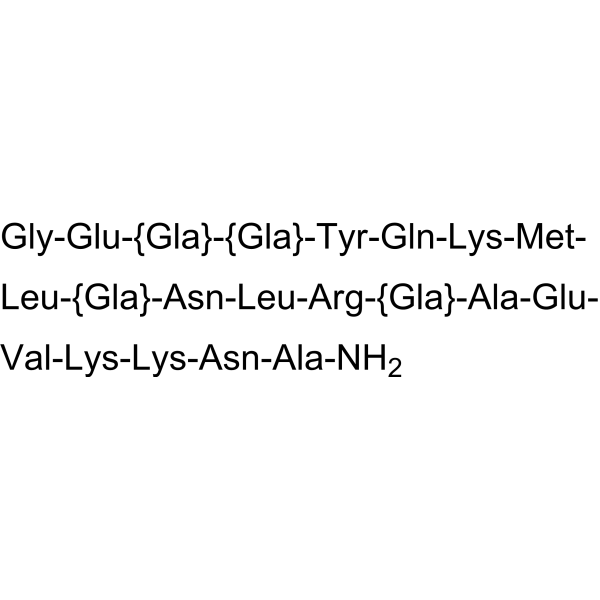
-
- HY-147260
-
|
SAGE-718
|
iGluR
|
Others
|
|
Dalzanemdor (SAGE-718) is a N-methyl-D-aspartate (NMDA) receptor positive allosteric modulator .
|
-
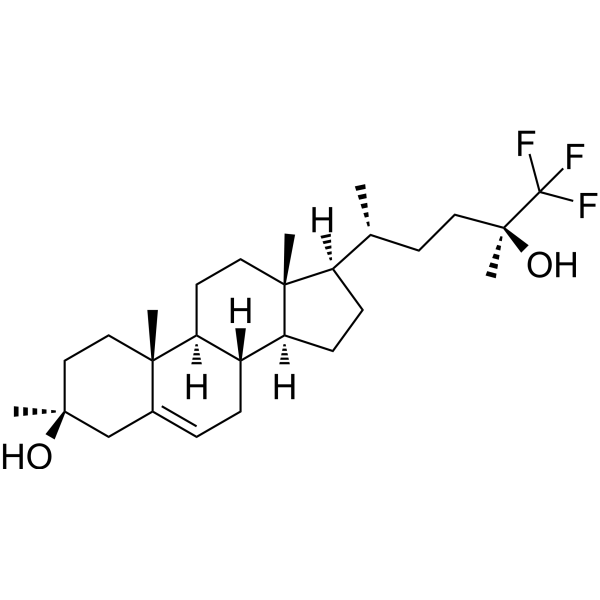
-
- HY-100807R
-
|
|
Endogenous Metabolite
iGluR
|
Neurological Disease
Inflammation/Immunology
|
|
Quinolinic acid (Standard) is the analytical standard of Quinolinic acid. This product is intended for research and analytical applications. Quinolinic acid is an endogenous N-methyl-D-aspartate (NMDA) receptor agonist synthesized from L-tryptophan via the kynurenine pathway and thereby has the potential of mediating N-methyl-D-aspartate neuronal damage and dysfunction .
|
-
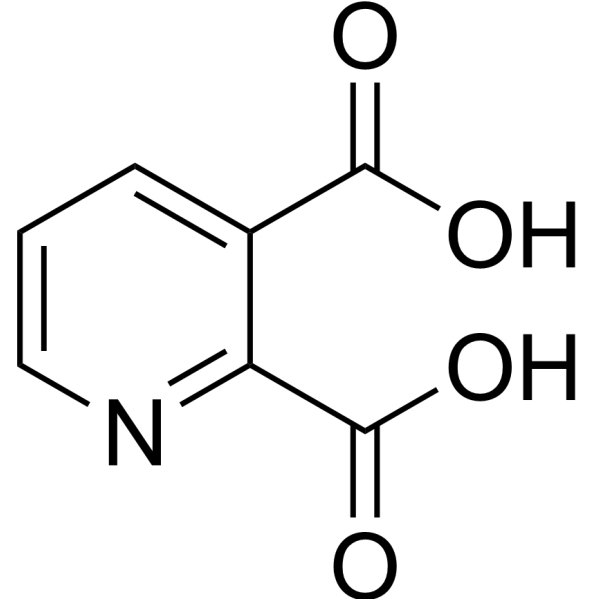
-
- HY-N2311
-
|
(RS)-Ibotenic acid; DL-Ibotenic acid
|
iGluR
|
Neurological Disease
|
|
Ibotenic acid has agonist activity at both the N-methyl-D-aspartate (NMDA) and trans-ACPD or metabolotropic quisqualate (Qm) receptor sites.
|
-

-
- HY-101353
-
|
(-)-LY 235959
|
iGluR
|
Neurological Disease
|
|
LY 235959 is a competitive N-methyl-D-aspartate (NMDA)-receptor antagonist. LY 235959 potentiates the anticonvulsant action of antiepileptics .
|
-
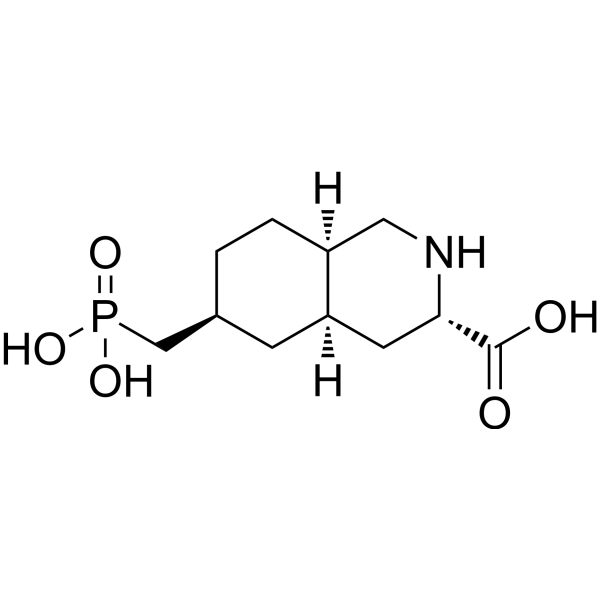
-
- HY-100807S1
-
|
|
Isotope-Labeled Compounds
|
Others
|
|
Quinolinic acid- 13C7is the 13C labeledQuinolinic acid(HY-100807) . Quinolinic acid is an endogenous N-methyl-D-aspartate (NMDA) receptor agonist synthesized from L-tryptophan via the kynurenine pathway and thereby has the potential of mediating N-methyl-D-aspartate neuronal damage and dysfunction .
|
-
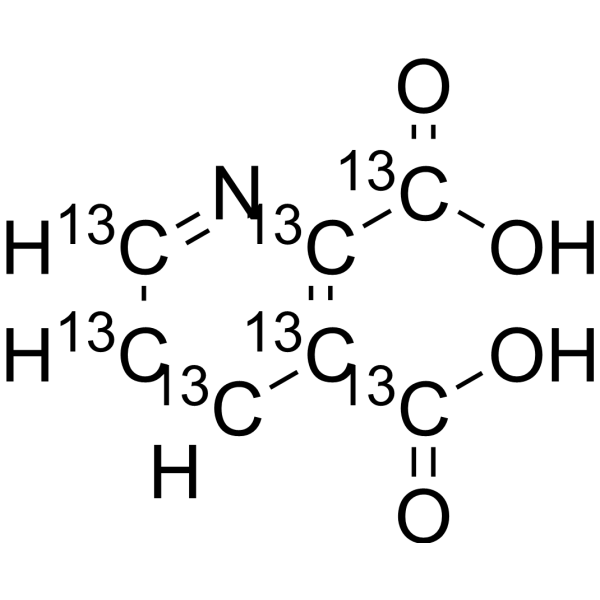
-
- HY-B0184A
-
|
W-554 hydrate; ADD-03055 hydrate
|
iGluR
|
Neurological Disease
|
|
Felbamate hydrate (W-554 hydrate) is a potent nonsedative anticonvulsant whose clinical effect may be related to the inhibition of N-methyl-D-aspartate (NMDA) .
|
-
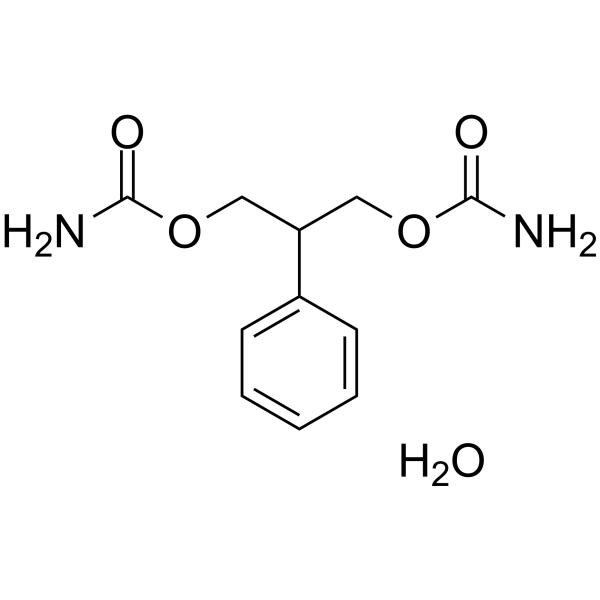
-
- HY-B0184
-
|
W-554; ADD-03055
|
iGluR
|
Neurological Disease
|
|
Felbamate (W-554) is a potent nonsedative anticonvulsant whose clinical effect may be related to the inhibition of N-methyl-D-aspartate (NMDA).
|
-
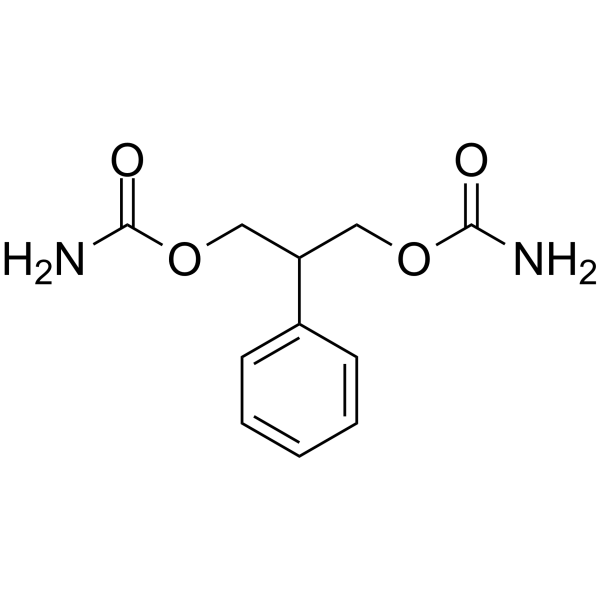
-
- HY-N2370
-
|
|
iGluR
LXR
|
Neurological Disease
|
|
24-Hydroxycholesterol is a natural sterol, which serves as a positive allosteric modulator of N-Methyl-d-Aspartate (NMDA) receptorsR, and a potent activator of the transcription factors LXR.
|
-

-
- HY-109164
-
|
AGN-241751; GATE-251
|
iGluR
|
Neurological Disease
|
|
Zelquistinel (AGN-241751) is a N-methyl-D-aspartate (NMDA) receptor partial agonist used for the research of depression, anxiety and other related psychiatric disorders .
|
-
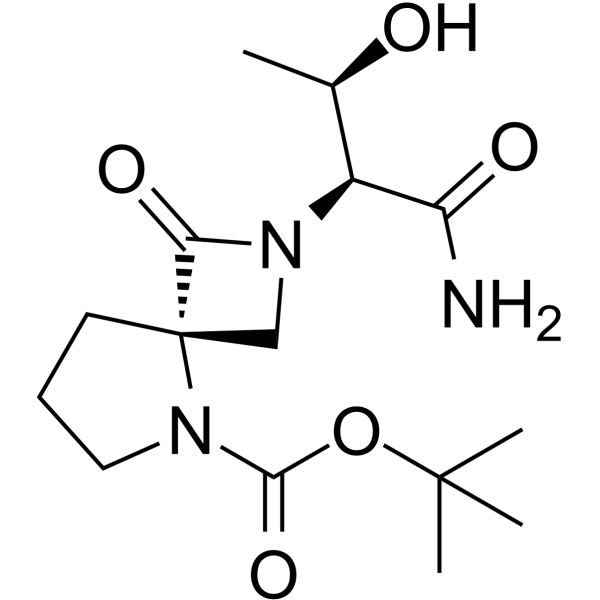
-
- HY-107702
-
|
|
iGluR
|
Neurological Disease
|
|
CGP 37849 is a potent, competitive and orally active N-methyl-D-aspartate (NMDA) receptor antagonist. CGP 37849 is an anticonvulsant in rodents and has antidepressant and anxiolytic-like effects .
|
-
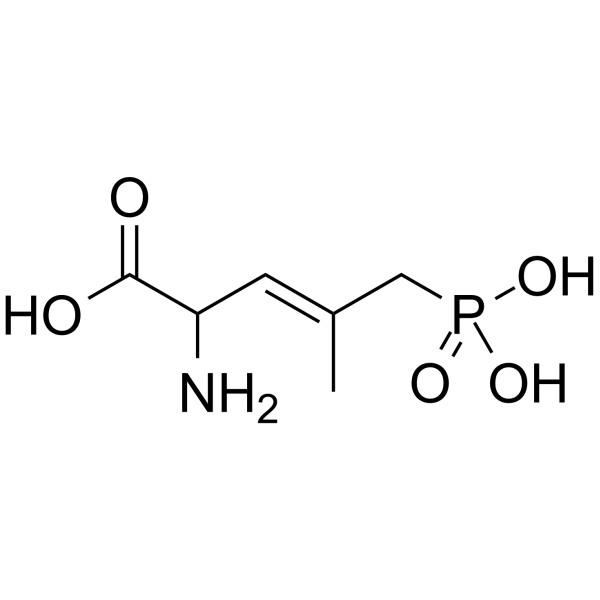
-
- HY-B0184S1
-
|
Felbamyl-d5; Felbatol-d5; Taloxa-d5
|
iGluR
|
Neurological Disease
|
|
Felbamate-d5 is the deuterium labeled Felbamate[1]. Felbamate (W-554) is a potent nonsedative anticonvulsant whose clinical effect may be related to the inhibition of N-methyl-D-aspartate (NMDA)[2][3].
|
-
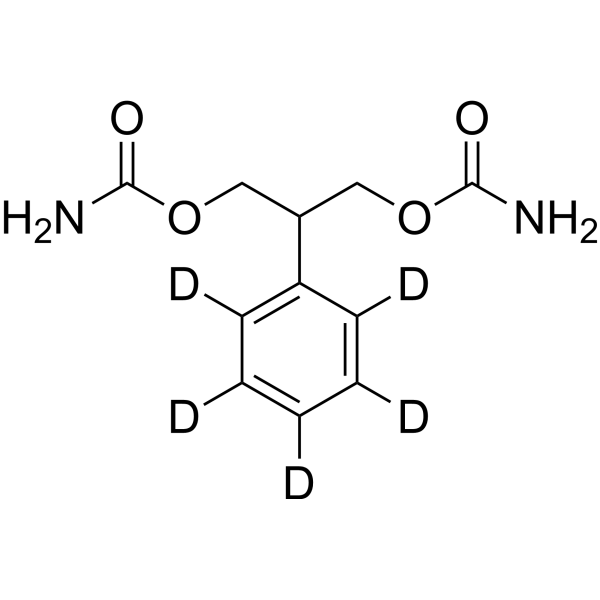
-
- HY-15084A
-
|
(-)-MK-801 maleate
|
iGluR
|
Neurological Disease
|
|
(-)-Dizocilpine maleate ((-)-MK-801 maleate) is a less active (-)-enantiomer of Dizocilpine. (-)-Dizocilpine maleate is a selective and non-competitive N-methyl-D-aspartate (NMDA) receptor antagonist with a Ki of 211.7 nM. (-)-Dizocilpine maleate has antidepressant effects .
|
-
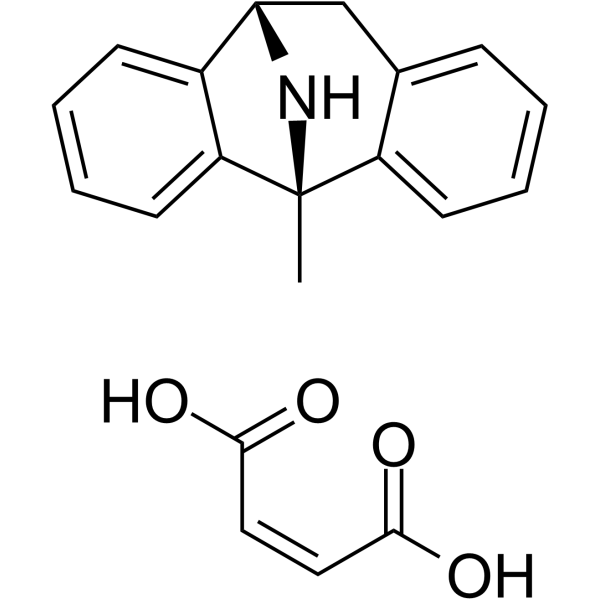
-
- HY-106441A
-
|
MK-0657; CERC-301
|
iGluR
|
Neurological Disease
|
|
Rislenemdaz (CERC-301) is an orally bioavailable and selective N-methyl-D-aspartate (NMDA) receptor subunit 2B (GluN2B) antagonist with Ki and IC 50 of 8.1 nM and 3.6 nM, respectively.
|
-
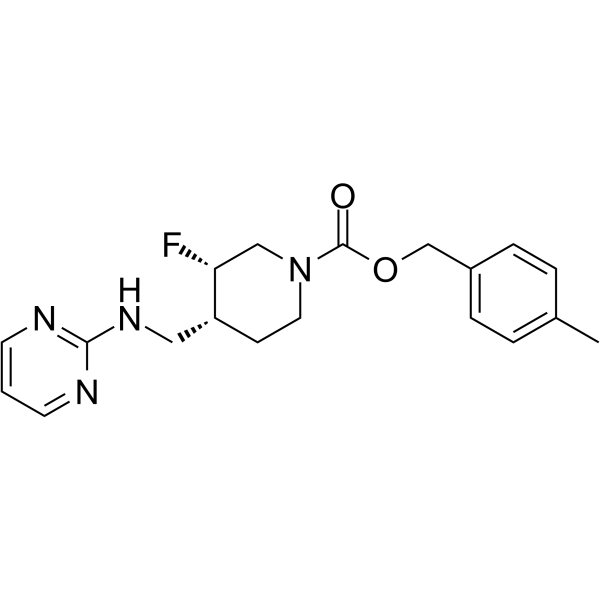
-
- HY-45609
-
|
|
iGluR
Endogenous Metabolite
|
Neurological Disease
|
|
L-Cysteine S-sulfate sodium hydrate is a potent N-methyl-d-aspartate (NMDA) glutamatergic receptors agonist. L-Cysteine S-sulfate sodium hydrate is the substrate for cystine lyase, it can be used in mass spectrometry operations .
|
-
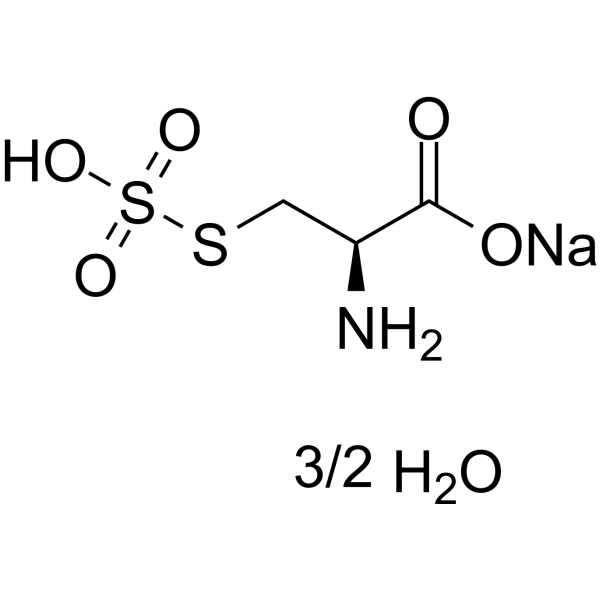
-
- HY-106408A
-
|
Salfaprodil; Neu2000 potassium
|
iGluR
|
Neurological Disease
|
|
Nelonemdaz (Salfaprodil) potassium is an NR2B-selective and uncompetitive antagonist of N-methyl-D-aspartate (NMDA). Nelonemdaz potassium is also a free radical scavenger. Nelonemdaz potassium has excellent neuroprotection against NMDA- and free radical-induced cell death .
|
-
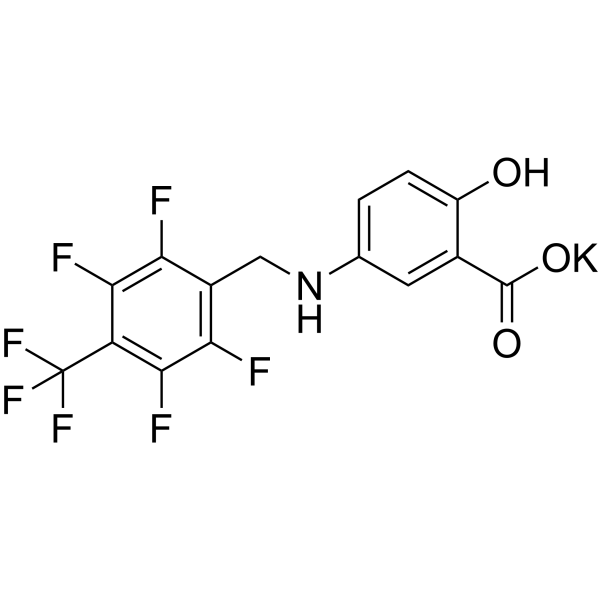
-
- HY-100807S2
-
-
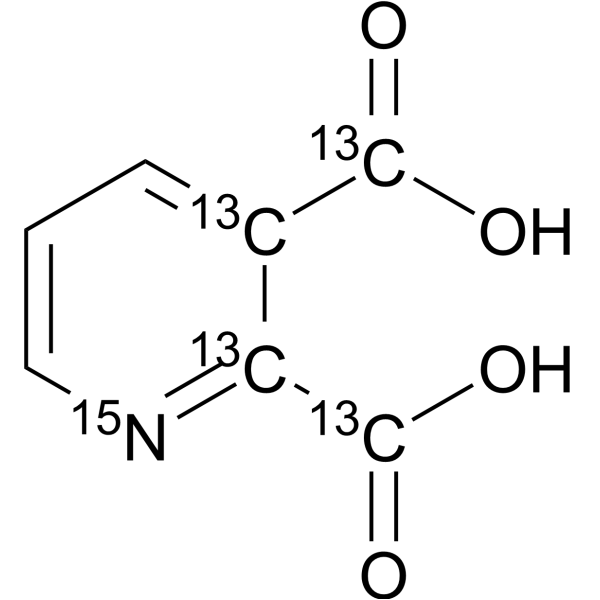
-
- HY-113084
-
|
|
iGluR
Endogenous Metabolite
|
Neurological Disease
|
|
L-Cysteine S-sulfate is a potent N-methyl-d-aspartate (NMDA) glutamatergic receptor agonist. L-Cysteine S-sulfate is the substrate for cystine lyase, and can be used in mass spectrometry operations .
|
-
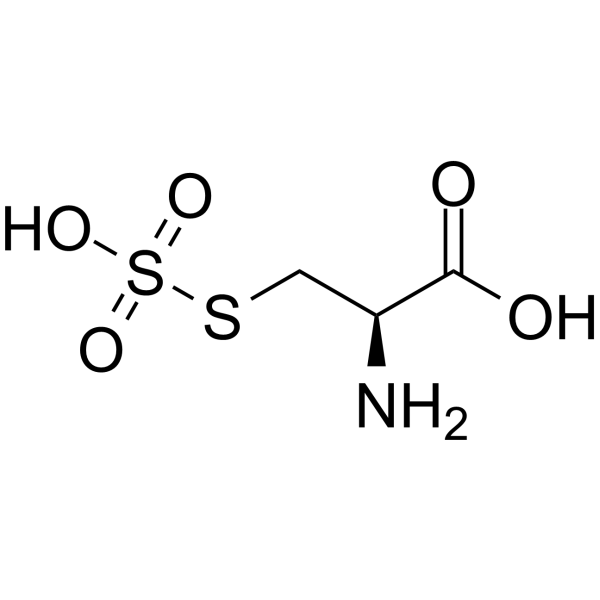
-
- HY-100787
-
|
|
iGluR
Endogenous Metabolite
|
Neurological Disease
|
|
L-Cysteine S-sulfate sodium is a potent N-methyl-d-aspartate (NMDA) glutamatergic receptors agonist. L-Cysteine S-sulfate sodium hydrate is the substrate for cystine lyase, it can be used in mass spectrometry operations .
|
-
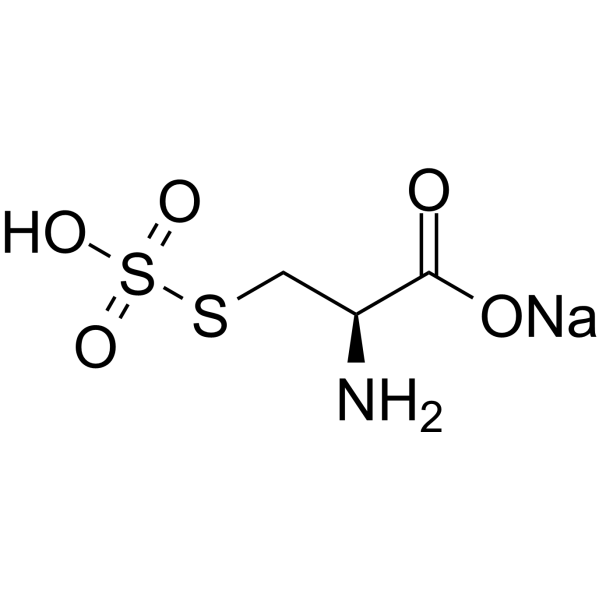
-
- HY-B0184R
-
|
W-554 (Standard); ADD-03055 (Standard)
|
iGluR
|
Neurological Disease
|
|
Felbamate (Standard) is the analytical standard of Felbamate. This product is intended for research and analytical applications. Felbamate (W-554) is a potent nonsedative anticonvulsant whose clinical effect may be related to the inhibition of N-methyl-D-aspartate (NMDA).
|
-
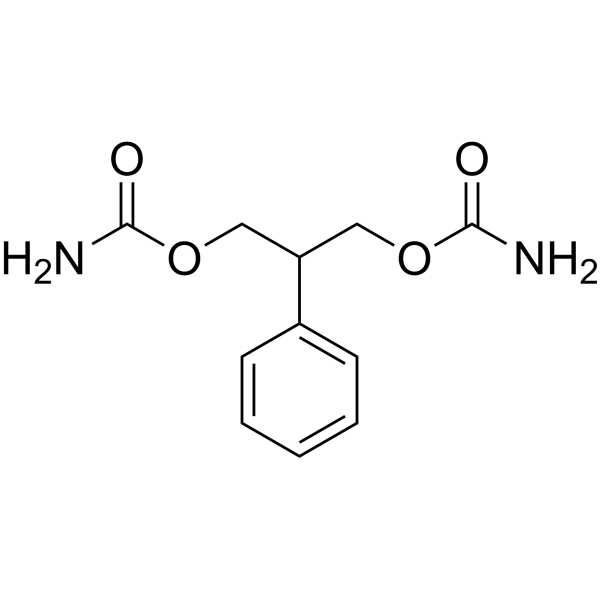
-
- HY-P1293
-
|
|
iGluR
|
Neurological Disease
|
|
Conantokin G, a 17-amino-acid peptide, is a potent, selective and competitive antagonist of N-methyl-D-aspartate (NMDA) receptors. Conantokin G inhibits NMDA-evoked currents in murine cortical neurons with an IC50 of 480 nM. Conantokin G has neuroprotective properties .
|
-
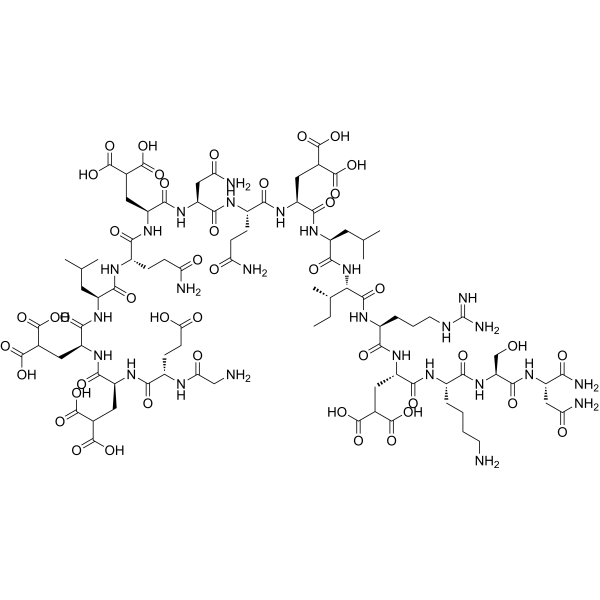
-
- HY-106408
-
|
Salfaprodil free base; Neu2000
|
iGluR
|
Neurological Disease
|
|
Nelonemdaz (Salfaprodil free base) is an NR2B-selective and uncompetitive antagonist of N-methyl-D-aspartate (NMDA). Nelonemdaz is also a free radical scavenger. Nelonemdaz has excellent neuroprotection against NMDA- and free radical-induced cell death .
|
-

-
- HY-129692
-
|
|
iGluR
|
Neurological Disease
|
|
Withanone is an active constituent from Withania somnifera roots with multifunctional neuroprotective effect in alleviating cognitive dysfunction. Withanone affords protection against N-methyl-D-aspartate (NMDA)-induced excitotoxicity in Neuron-like cells .
|
-

-
- HY-107694
-
|
(Rac)-MK-801
|
Others
|
Others
|
|
(Rac)-Dizocilpine ((Rac)-MK-801) is the racemate of Dizocilpine (HY-15084B). Dizocilpine (MK-801), a potent anticonvulsant, is a selective and non-competitive N-methyl-D-aspartate (NMDA) receptor antagonist .
|
-

-
- HY-114869
-
|
|
PARP
|
Neurological Disease
|
|
DPQ is a potent PARP-1 inhibitor. DPQ can reduce the N-methyl-d-aspartate (NMDA)-induced PARP activation, restoring ATP to near control levels and significantly attenuating neuronal injury in the severe NMDA exposure model. DPQ can be used for researching neuroprotection .
|
-

-
- HY-101037
-
|
N-methylglycine; Sarcosin
|
|
|
|
Sarcosine (N-Methylglycine), an endogenous amino acid, is a competitive glycine transporter type I (GlyT1) inhibitor and N-methyl-D-aspartate (NMDA) receptor co-agonist. Sarcosine increases the glycine concentration, resulting in an indirect potentiation of the NMDA receptor. Sarcosine is commonly used for the research of schizophrenia .
|
-
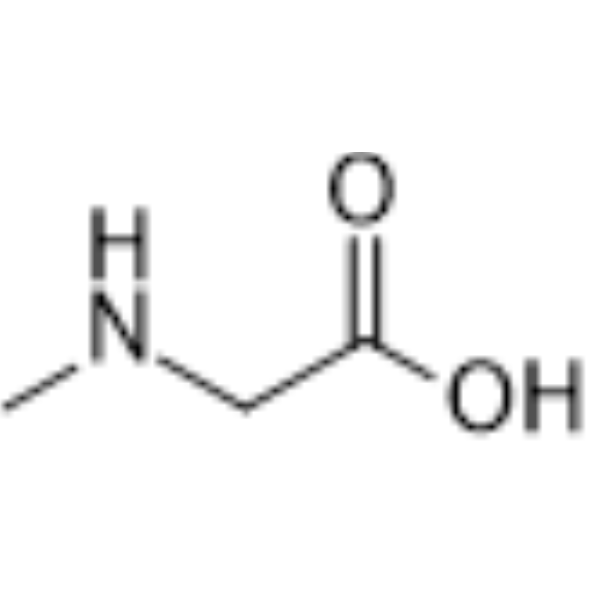
-
- HY-101178
-
|
|
iGluR
|
Neurological Disease
|
|
L-689560 is a potent N-methyl-D-aspartate (NMDA) receptor antagonist at the GluN1 glycine binding site. L-689560 is widely used as a radiolabeled ligand in binding studies and used for study the roles of NMDA receptors in normal neurological processes as well as in diseases .
|
-

-
- HY-P1293A
-
|
|
iGluR
|
Neurological Disease
|
|
Conantokin G TFA, a 17-amino-acid peptide, is a potent, selective and competitive antagonist of N-methyl-D-aspartate (NMDA) receptors. Conantokin G TFA inhibits NMDA-evoked currents in murine cortical neurons with an IC50 of 480 nM. Conantokin G TFA has neuroprotective properties .
|
-

-
- HY-B1487
-
|
Tricyclamol hydrochloride; (±)-Procyclidine hydrochloride
|
iGluR
mAChR
|
Neurological Disease
|
|
Procyclidine (Tricyclamol, (±)-Procyclidine) hydrochloride , an anticholinergic agent, is a muscarinic receptor antagonist that also has the properties of an N-methyl-D-aspartate (NMDA) antagonist. Procyclidine hydrochloride can be used in studies of Parkinson's disease and related psychiatric disorders such as Soman-induced epilepsy .
|
-
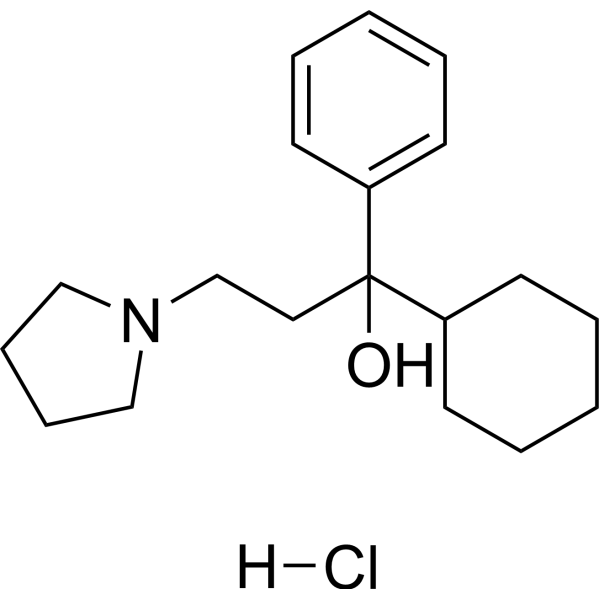
-
- HY-B0184S
-
|
|
iGluR
|
Neurological Disease
|
|
Felbamate-d4 (W-554-d4) is the deuterium labeled Felbamate. Felbamate (W-554) is a potent anticonvulsant whose clinical effect may be related to the inhibition of N-methyl-D-aspartate (NMDA).
|
-
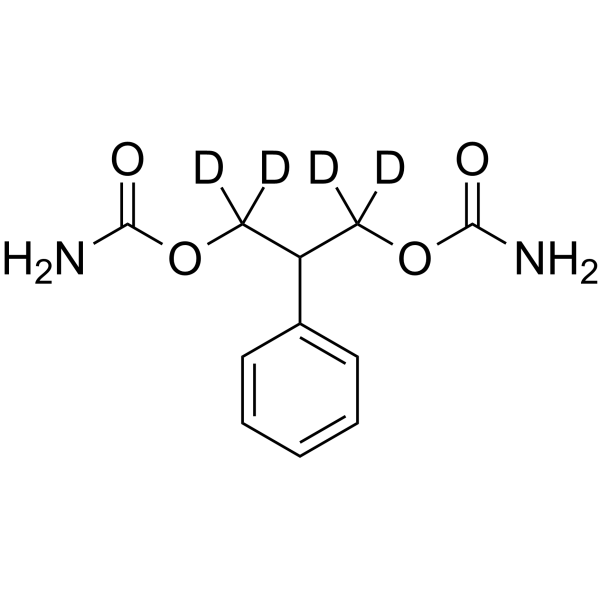
-
- HY-B1487A
-
|
Tricyclamol; (±)-Procyclidine
|
|
|
|
Procyclidine (Tricyclamol; (±)-Procyclidine), an anticholinergic agent, is a muscarinic receptor antagonist that also has the properties of an N-methyl-D-aspartate (NMDA) antagonist. Procyclidine can be used in studies of Parkinson's disease and related psychiatric disorders such as Soman-induced epilepsy .
|
-
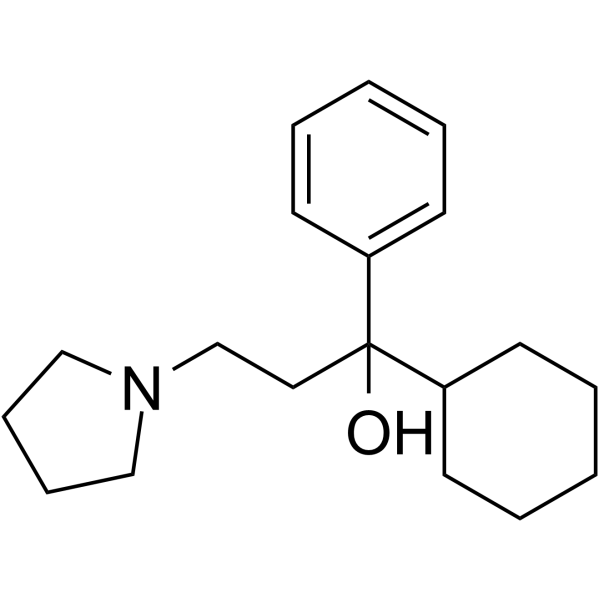
-
- HY-139048
-
|
|
iGluR
|
Neurological Disease
|
|
Fluoroethylnormemantine, a derivative of Memantine, is an antagonist of the N-methyl-D-aspartate (NMDA) receptor. [ 18F]-Fluoroethylnormemantine can be used as a positron emission tomography (PET) tracer. Fluoroethylnormemantine exhibits anti-amnesic, neuroprotective, antidepressant-like and fear-attenuating effects .
|
-
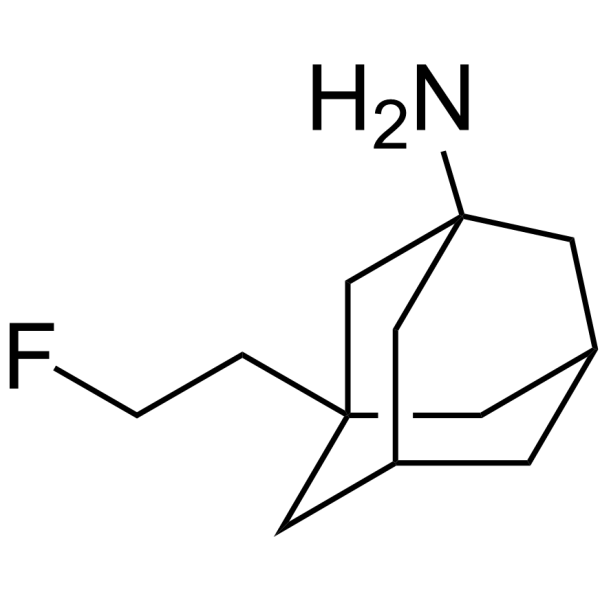
-
- HY-139048A
-
|
|
iGluR
|
Neurological Disease
|
|
Fluoroethylnormemantine hydrochloride, a derivative of Memantine, is an antagonist of the N-methyl-D-aspartate (NMDA) receptor. [ 18F]-Fluoroethylnormemantine hydrochloride can be used as a positron emission tomography (PET) tracer. Fluoroethylnormemantine hydrochloride exhibits anti-amnesic, neuroprotective, antidepressant-like and fear-attenuating effects .
|
-
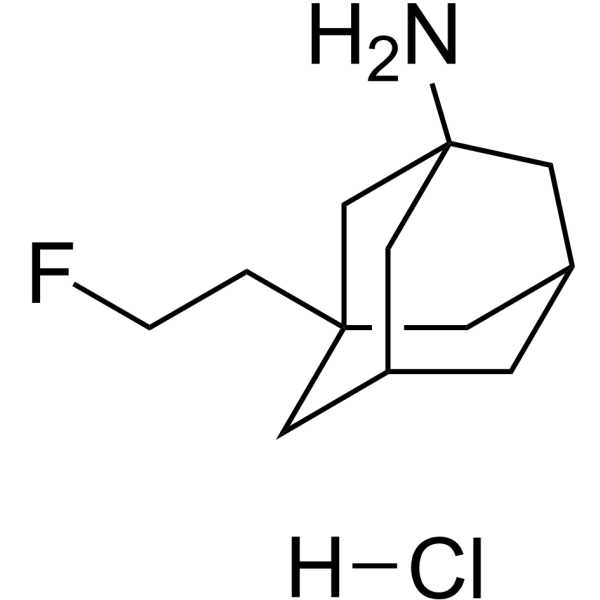
-
- HY-107703
-
|
|
iGluR
|
Neurological Disease
|
|
CGP 39551 is a potent, orally active, competitive N-methyl-D-aspartate (NMDA) receptor antagonist with potent anticonvulsant activity . CGP 39551 shows measurable inhibitory activity at both L-[ 3H]-glutamate (Ki=8.4 μM) .
|
-
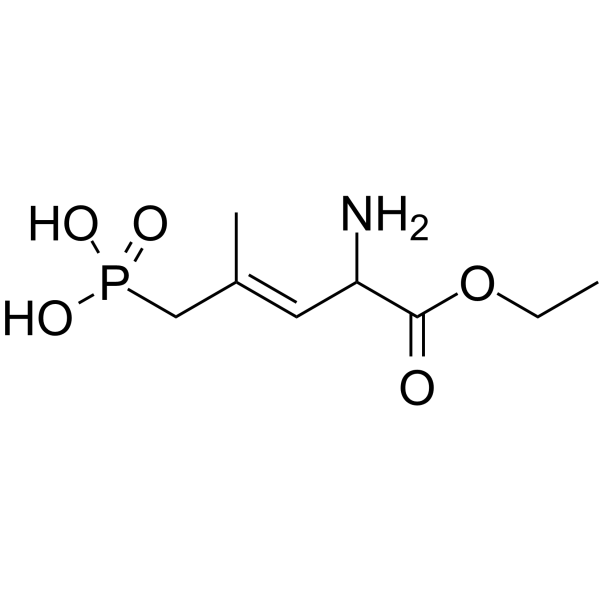
-
- HY-156634
-
|
NYX-783
|
iGluR
|
Neurological Disease
|
|
Risevistinel (NYX-783) is a positive allosteric modulator of N-methyl-D-aspartate (NMDA) receptor. Nevadistinel can be used to inhibit cognitive impairment associated with neurodegenerative diseases, such as mild cognitive impairment, mild Alzheimer's disease, Parkinson's disease, Lewy body disease .
|
-

-
- HY-101229
-
|
|
|
|
|
(2R,3R)-Chlorpheg is a week antagonist of L-homocysteic acid (L-HCA) induced depolarization.(2R,3R)-Chlorpheg also is a weak N-methyl-D-aspartate (NMDA) antagonist .
|
-
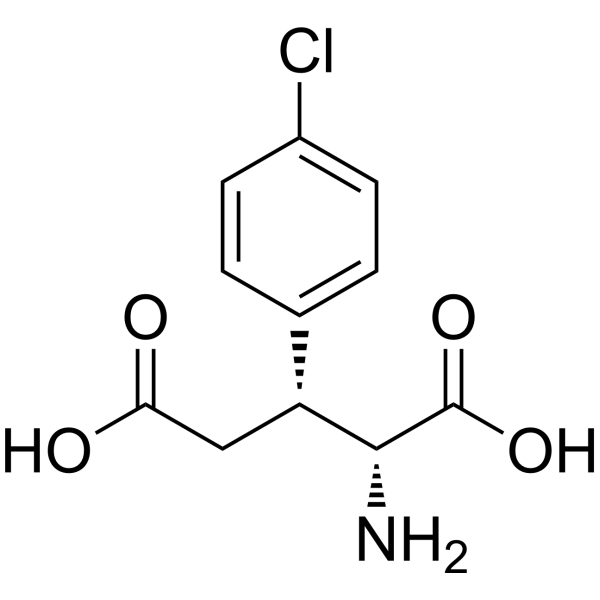
-
- HY-109097
-
|
SP-8203
|
MMP
iGluR
|
Neurological Disease
|
|
Otaplimastat (SP-8203), a matrix metalloproteinase (MMP) inhibitor, blocks N-methyl-D-aspartate (NMDA) receptor-mediated excitotoxicity in a competitive manner. Otaplimastat also exhibits anti-oxidant activity. Otaplimastat can be used for the research of brain ischemic injury .
|
-
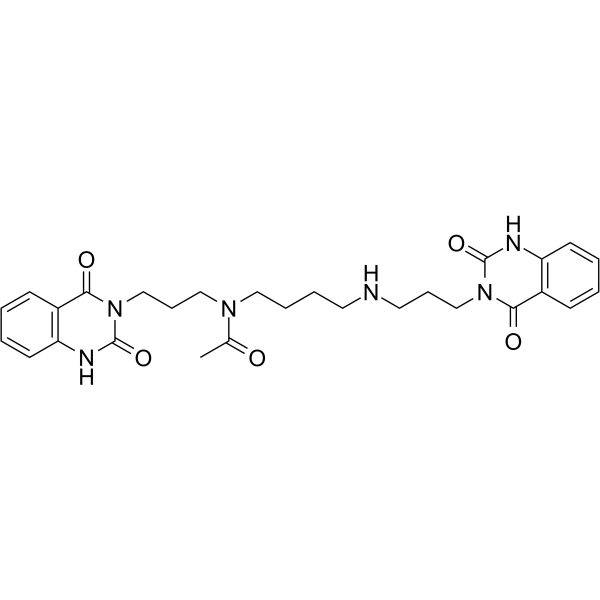
-
- HY-100714
-
|
2-APV; DL-2-Amino-5-phosphonovaleric acid
|
|
|
|
DL-AP5 (2-APV) is a competitive NMDA (N-methyl-D-aspartate) receptor antagonist. DL-AP5 shows significantly antinociceptive activity. DL-AP5 specifically blocks on channels in the rabbit retina .
|
-
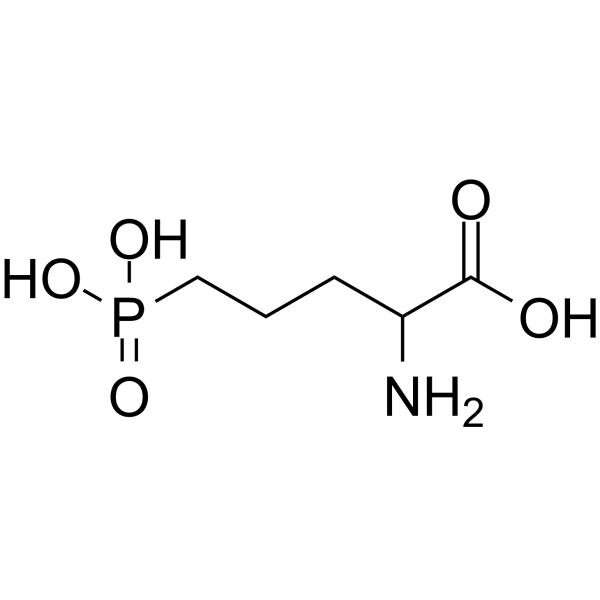
-
- HY-100714C
-
|
2-APV sodium; DL-2-Amino-5-phosphonovaleric acid sodium
|
iGluR
|
Neurological Disease
Inflammation/Immunology
|
|
DL-AP5 (2-APV) sodium is a competitive NMDA (N-methyl-D-aspartate) receptor antagonist. DL-AP5 sodium shows significantly antinociceptive activity. DL-AP5 sodium specifically blocks on channels in the rabbit retina .
|
-
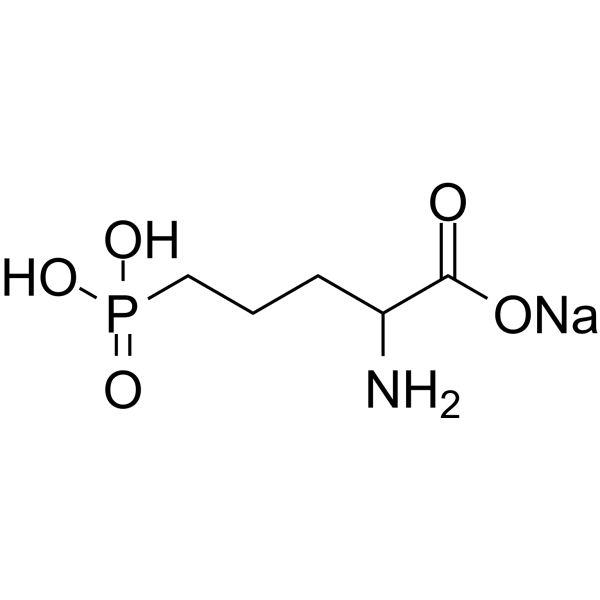
-
- HY-19391
-
-

-
- HY-101037S1
-
|
N-methylglycine-d3; Sarcosin-d3
|
Isotope-Labeled Compounds
Endogenous Metabolite
GlyT
|
Cancer
|
|
Sarcosine-d3 is the deuterium labeled Sarcosine. Sarcosine (N-Methylglycine), an endogenous amino acid, is a competitive glycine transporter type I (GlyT1) inhibitor and N-methyl-D-aspartate (NMDA) receptor co-agonist. Sarcosine increases the glycine concentration, resulting in an indirect potentiation of the NMDA receptor. Sarcosine is commonly used for the research of schizophrenia[1][2].
|
-

-
- HY-156626
-
|
NYX-458; NYX-3054
|
iGluR
|
Neurological Disease
|
|
Nevadistinel (NYX-458; NYX-3054) is a positive allosteric modulator of N-methyl-D-aspartate (NMDA) receptor. Nevadistinel can be used to inhibit cognitive impairment associated with neurodegenerative diseases, such as mild cognitive impairment, mild Alzheimer's disease, Parkinson's disease, Lewy body disease .
|
-

-
- HY-P3679
-
|
|
Neuropeptide Y Receptor
|
|
|
Neuropeptide Y (1-24) (human) is a neuropeptide with potencies in inhibiting the electricity stimulated twitch response of rat vas deferens. Neuropeptide Y (1-24) (human) stimulates N-methyl-D-aspartate (NMDA)-induced neuronal activation in the rat CA3 region of the dorsal hippocampus in vivo .
|
-

-
- HY-101037S
-
|
N-methylglycine-15N; Sarcosin-15N
|
Endogenous Metabolite
GlyT
|
Cancer
|
|
Sarcosine- 15N is the 15N-labeled Sarcosine. Sarcosine (N-Methylglycine), an endogenous amino acid, is a competitive glycine transporter type I (GlyT1) inhibitor and N-methyl-D-aspartate (NMDA) receptor co-agonist. Sarcosine increases the glycine concentration, resulting in an indirect potentiation of the NMDA receptor. Sarcosine is commonly used for the research of schizophrenia[1][2].
|
-

-
- HY-153129
-
|
|
Prostaglandin Receptor
|
Endocrinology
|
|
EP2 receptor antagonist-2 (CID891729) is an antagonist of EP2 receptor. EP2 receptor antagonist-2 inhibits the EP2 receptor activation induced by PGE2. EP2 receptor antagonist-2 also suppresses lactate dehydrogenase (LDH) release induced by N-methyl-D-aspartate (NMDA) .
|
-

-
- HY-G0021
-
|
Norclozapine; Desmethylclozapine; Normethylclozapine
|
mAChR
Opioid Receptor
Drug Metabolite
Virus Protease
|
Infection
|
|
N-Desmethylclozapine is a major active metabolite of the atypical antipsychotic agent Clozapine. N-Desmethylclozapine is a potent, allosteric and partial M1 receptors agonist (EC50=115 nM) and is able to potentiate hippocampal N-methyl-d-aspartate (NMDA) receptor currents through M1 receptor activation. N-Desmethylclozapine is also a δ-opioid agonist .
|
-
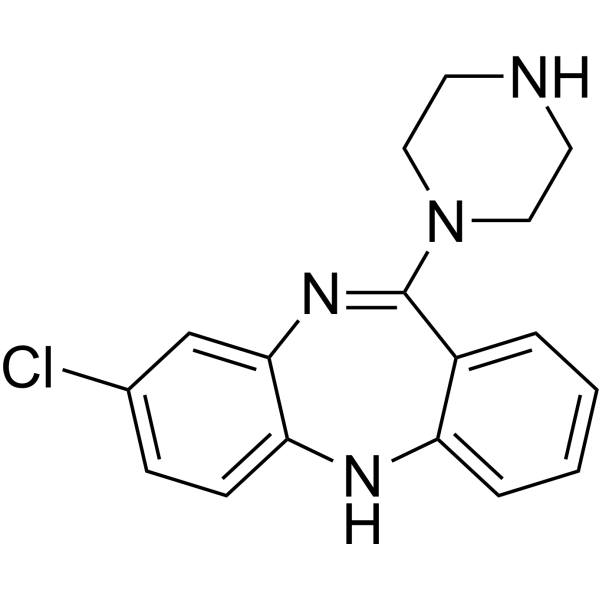
-
- HY-100822
-
|
(+)-HA-966
|
|
|
|
(R)-(+)-HA-966 ((+)-HA-966) is a partial agonist/antagonist of glycine site of the N-methyl-D-aspartate (NMDA) receptor complex. (R)-(+)-HA-966 selectively blocks the activation of the mesolimbic dopamine system by amphetamine . (R)-(+)-HA-966 can cross the blood-brain barrier and has the potential for neuropathic and acute pain .
|
-
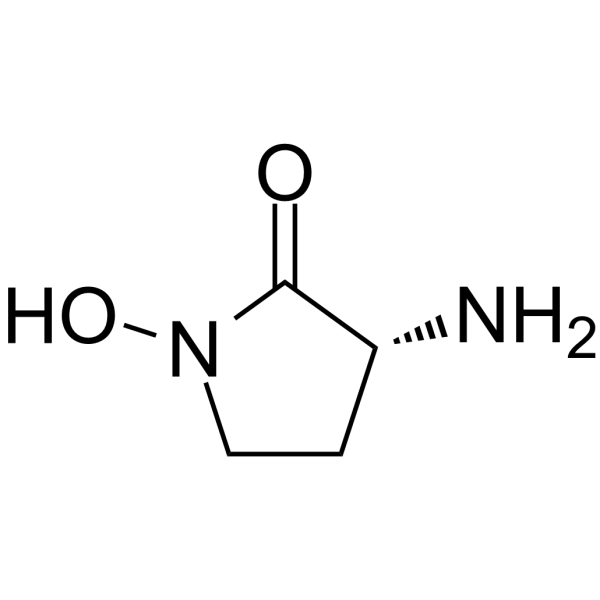
- HY-17387
-
|
Huperzine A
|
Cholinesterase (ChE)
Apoptosis
iGluR
|
Neurological Disease
|
|
(-)-Huperzine A (Huperzine A) is an alkaloid isolated from Huperzia serrata, with neuroprotective activity. (-)-Huperzine A is a potent, highly specific, reversible and blood-brain barrier penetrant inhibitor of acetylcholinesterase (AChE), with an IC50 of 82 nM. (-)-Huperzine A also is non-competitive antagonist of N-methyl-D-aspartate glutamate (NMDA) receptor. (-)-Huperzine A is developed for the research of neurodegenerative diseases, including Alzheimer’s disease .
|
-
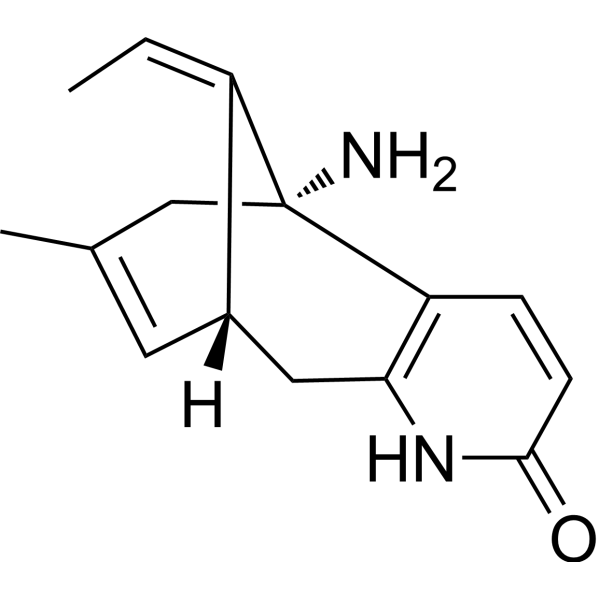
- HY-139580
-
|
CAD-9303
|
iGluR
|
Neurological Disease
|
|
Plazinemdor is a N-methyl-D-aspartate(NMDA) receptor positive allosteric modulator. Plazinemdor can be uses in the research of psychiatric, neurological, and neurodevelopmental disorders, as well as diseases of the nervous system ..
|
-

- HY-100811
-
|
7-CKA
|
iGluR
|
Neurological Disease
|
|
7-Chlorokynurenic acid (7-CKA) is a potent and selective antagonist of the glycine B coagonist site of the N-methyl-D-aspartate (NMDA) receptor (IC50=0.56 μM). 7-Chlorokynurenic acid is also a potent inhibitor of the reuptake of glutamate into synaptic vesicles with a Ki of 0.59 μM. 7-Chlorokynurenic acid has potent antinociceptive actions after neuraxial delivery .
|
-
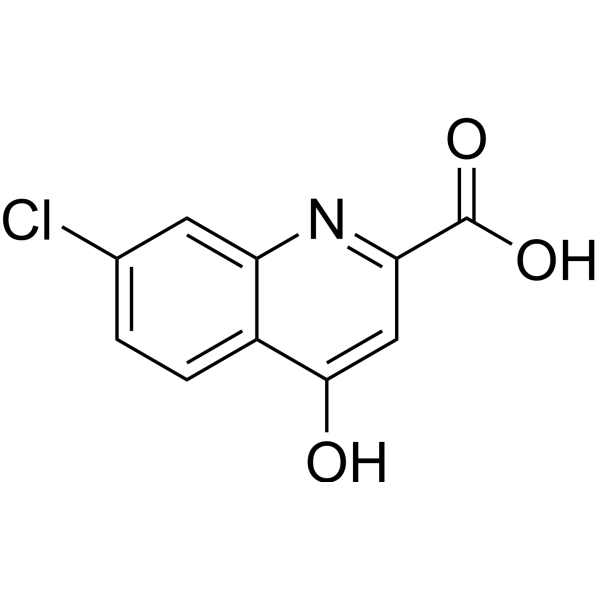
- HY-100811A
-
|
7-CKA sodium salt
|
iGluR
|
Neurological Disease
|
|
7-Chlorokynurenic acid sodium salt (7-CKA sodium salt) is a potent and selective antagonist of the glycine B coagonist site of the N-methyl-D-aspartate (NMDA) receptor (IC50=0.56 μM). 7-Chlorokynurenic acid sodium salt is also a potent inhibitor of the reuptake of glutamate into synaptic vesicles with a Ki of 0.59 μM. 7-Chlorokynurenic acid sodium salt has potent antinociceptive actions after neuraxial delivery .
|
-
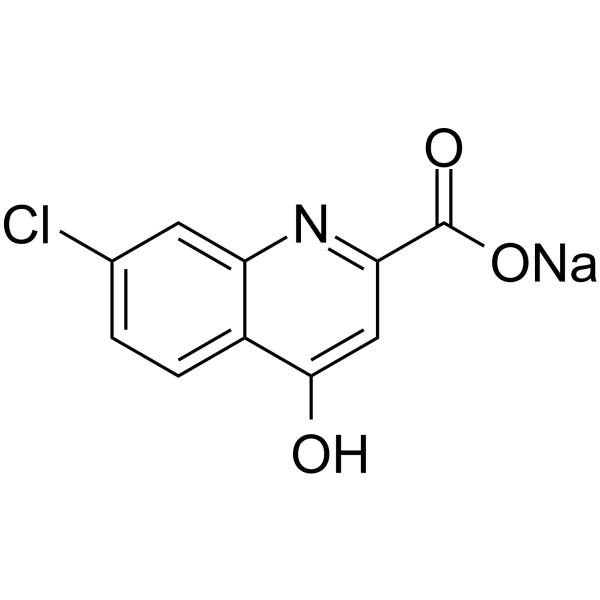
- HY-G0021S
-
|
Norclozapine-d8; Desmethylclozapine-d8; Normethylclozapine-d8
|
mAChR
Opioid Receptor
Drug Metabolite
Virus Protease
|
Infection
|
|
N-Desmethylclozapine-d8 is the deuterium labeled N-Desmethylclozapine. N-Desmethylclozapine is a major active metabolite of the atypical antipsychotic agent Clozapine. N-Desmethylclozapine is a potent, allosteric and partial M1 receptors agonist (EC50=115 nM) and is able to potentiate hippocampal N-methyl-d-aspartate (NMDA) receptor currents through M1 receptor activation. N-Desmethylclozapine is also a δ-opioid agonist[1][2].
|
-
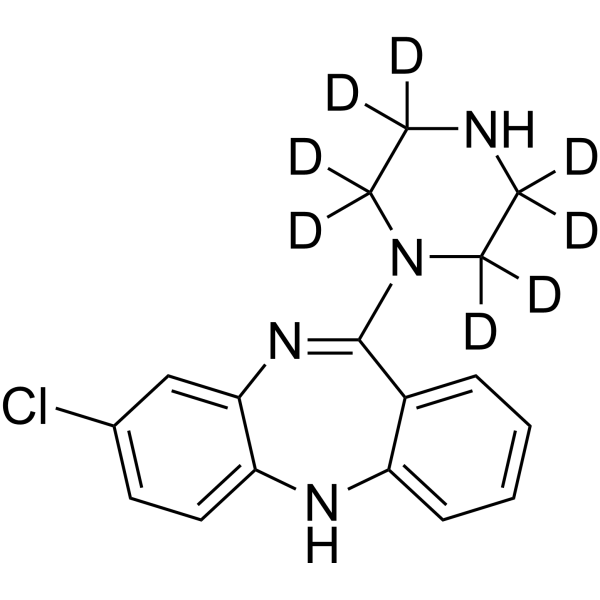
- HY-G0021S1
-
|
Norclozapine-d8 hydrochloride; Desmethylclozapine-d8 hydrochloride; Normethylclozapine-d8 hydrochloride
|
mAChR
Opioid Receptor
Drug Metabolite
Virus Protease
|
Infection
|
|
N-Desmethylclozapine-d8 (hydrochloride) is the deuterium labeled N-Desmethylclozapine hydrochloride. N-Desmethylclozapine hydrochloride is a major active metabolite of the atypical antipsychotic agent Clozapine. N-Desmethylclozapine hydrochloride is a potent, allosteric and partial M1 receptors agonist (EC50=115 nM) and is able to potentiate hippocampal N-methyl-d-aspartate (NMDA) receptor currents through M1 receptor activation. N-Desmethylclozapine hydrochloride is also a δ-opioid agonist[1][2][3].
|
-
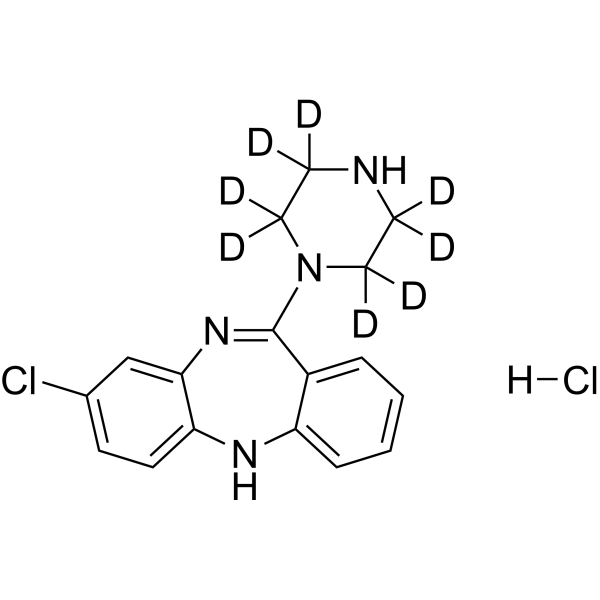
- HY-148825
-
-
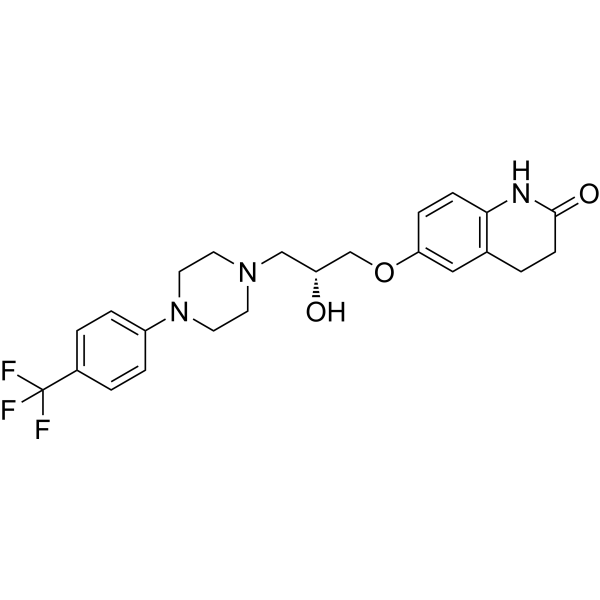
- HY-100839
-
|
D,L-(tetrazol-5-yl)glycine; LY 285265
|
|
|
|
(RS)-(Tetrazol-5-yl)glycine (D,L-(tetrazol-5-yl)glycine) is a highly potent and selective N-methyl-D-aspartate (NMDA) receptor agonist . (RS)-(Tetrazol-5-yl)glycine has EC50s of 99 nM, 1.7 μM for GluN1/GluN2D and GluN1/GluN2A, respectively . (RS)-(Tetrazol-5-yl)glycine induces seizure responses and Fos in mice .
|
-
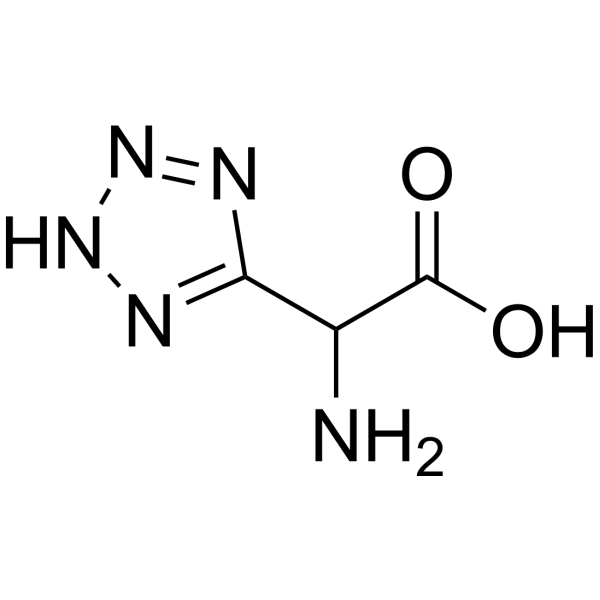
- HY-161211
-
|
|
17β-HSD
iGluR
|
Metabolic Disease
|
|
HSD17B13-IN-7 (compound 1), a fluorophenol-containing compound, is a potent HSD17B13 inhibitor with IC50s of 0.18 μM and 0.25 μM β-estradiol and Leukotriene B4 as substrates, respectively. HSD17B13-IN-7 is a potent N-methyl-D-aspartate (NMDA) NR2B receptor antagonist. HSD17B13-IN-7 has the potential for non-alcoholic fatty liver disease research .
|
-
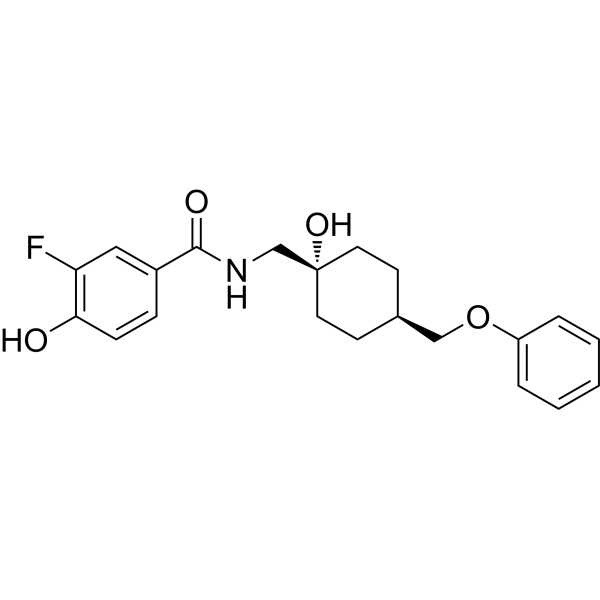
| Cat. No. |
Product Name |
Target |
Research Area |
-
- HY-P1287
-
|
|
iGluR
|
Neurological Disease
|
|
Conantokin-T is a γ-carboxyglutamate-containing, N-methyl-D-aspartate (NMDA) antagonist peptidewith an IC50 value of 2 μM. Conantokin-T inhibits NMDA receptor-mediated calcium influx in central nervous system neurons. Conantokin-T can be purified from the venom of the fish-hunting cone snail, Conus tulipa .
|
-
- HY-113084
-
|
|
iGluR
Endogenous Metabolite
|
Neurological Disease
|
|
L-Cysteine S-sulfate is a potent N-methyl-d-aspartate (NMDA) glutamatergic receptor agonist. L-Cysteine S-sulfate is the substrate for cystine lyase, and can be used in mass spectrometry operations .
|
-
- HY-P1293
-
|
|
iGluR
|
Neurological Disease
|
|
Conantokin G, a 17-amino-acid peptide, is a potent, selective and competitive antagonist of N-methyl-D-aspartate (NMDA) receptors. Conantokin G inhibits NMDA-evoked currents in murine cortical neurons with an IC50 of 480 nM. Conantokin G has neuroprotective properties .
|
-
- HY-P1293A
-
|
|
iGluR
|
Neurological Disease
|
|
Conantokin G TFA, a 17-amino-acid peptide, is a potent, selective and competitive antagonist of N-methyl-D-aspartate (NMDA) receptors. Conantokin G TFA inhibits NMDA-evoked currents in murine cortical neurons with an IC50 of 480 nM. Conantokin G TFA has neuroprotective properties .
|
-
- HY-P3679
-
|
|
Neuropeptide Y Receptor
|
|
|
Neuropeptide Y (1-24) (human) is a neuropeptide with potencies in inhibiting the electricity stimulated twitch response of rat vas deferens. Neuropeptide Y (1-24) (human) stimulates N-methyl-D-aspartate (NMDA)-induced neuronal activation in the rat CA3 region of the dorsal hippocampus in vivo .
|
-
- HY-117483
-
|
|
Peptides
|
Neurological Disease
|
|
Gly-Pro-Glu is a neuroactive peptide with a potent action on acetylcholine release. Gly-Pro-Glu is the N-terminal tripeptide of insulin-like growth factor-I. Gly-Pro-Glu inhibits glutamate binds to N-methyl-D-aspartate (NMDA) receptor with an IC50 value of 14.7 μM. Gly-Pro-Glu can be used for the research of neuroprotection .
|
| Cat. No. |
Product Name |
Category |
Target |
Chemical Structure |
| Cat. No. |
Compare |
Product Name |
Species |
Source |
Compare Products
|
| Products |
|
| Cat. No. |
|
| Species |
|
| Source |
|
| Tag |
|
| Accession |
|
| Gene ID |
|
| Molecular Weight |
|
| Purity |
|
| Endotoxin Level |
|
| Biological Activity |
|
| Appearance |
|
| Formulation |
|
| Storage & Stability |
|
| Shipping |
|
| Free Sample |
Yes
No
|
| Size |
* This product has been "discontinued".
Optimized version of product available:
|
| Cat. No. |
Product Name |
Chemical Structure |
-
- HY-100807S
-
|
|
|
Quinolinic acid-d3 is the deuterium labeled Quinolinic acid. Quinolinic acid is an endogenous N-methyl-D-aspartate (NMDA) receptor agonist synthesized from L-tryptophan via the kynurenine pathway and thereby has the potential of mediating N-methyl-D-aspartate neuronal damage and dysfunction[1][2].
|
-

-
- HY-B0184S
-
|
|
|
Felbamate-d4 (W-554-d4) is the deuterium labeled Felbamate. Felbamate (W-554) is a potent anticonvulsant whose clinical effect may be related to the inhibition of N-methyl-D-aspartate (NMDA).
|
-

-
- HY-100807S1
-
|
|
|
Quinolinic acid- 13C7is the 13C labeledQuinolinic acid(HY-100807) . Quinolinic acid is an endogenous N-methyl-D-aspartate (NMDA) receptor agonist synthesized from L-tryptophan via the kynurenine pathway and thereby has the potential of mediating N-methyl-D-aspartate neuronal damage and dysfunction .
|
-

-
- HY-B0184S1
-
|
|
|
Felbamate-d5 is the deuterium labeled Felbamate[1]. Felbamate (W-554) is a potent nonsedative anticonvulsant whose clinical effect may be related to the inhibition of N-methyl-D-aspartate (NMDA)[2][3].
|
-

-
- HY-100807S2
-
|
|
|
Quinolinic acid-13C4, 15N is an isotopic labeled Quinolinic acid (HY-100807). Quinolinic acid is an endogenous N-methyl-D-aspartate (NMDA) receptor agonist and has the potential of mediating NMDA neuronal damage and dysfunction .
|
-

-
- HY-101037S1
-
|
|
|
Sarcosine-d3 is the deuterium labeled Sarcosine. Sarcosine (N-Methylglycine), an endogenous amino acid, is a competitive glycine transporter type I (GlyT1) inhibitor and N-methyl-D-aspartate (NMDA) receptor co-agonist. Sarcosine increases the glycine concentration, resulting in an indirect potentiation of the NMDA receptor. Sarcosine is commonly used for the research of schizophrenia[1][2].
|
-

-
- HY-101037S
-
|
|
|
Sarcosine- 15N is the 15N-labeled Sarcosine. Sarcosine (N-Methylglycine), an endogenous amino acid, is a competitive glycine transporter type I (GlyT1) inhibitor and N-methyl-D-aspartate (NMDA) receptor co-agonist. Sarcosine increases the glycine concentration, resulting in an indirect potentiation of the NMDA receptor. Sarcosine is commonly used for the research of schizophrenia[1][2].
|
-

-
- HY-G0021S
-
|
|
|
N-Desmethylclozapine-d8 is the deuterium labeled N-Desmethylclozapine. N-Desmethylclozapine is a major active metabolite of the atypical antipsychotic agent Clozapine. N-Desmethylclozapine is a potent, allosteric and partial M1 receptors agonist (EC50=115 nM) and is able to potentiate hippocampal N-methyl-d-aspartate (NMDA) receptor currents through M1 receptor activation. N-Desmethylclozapine is also a δ-opioid agonist[1][2].
|
-

-
- HY-G0021S1
-
|
|
|
N-Desmethylclozapine-d8 (hydrochloride) is the deuterium labeled N-Desmethylclozapine hydrochloride. N-Desmethylclozapine hydrochloride is a major active metabolite of the atypical antipsychotic agent Clozapine. N-Desmethylclozapine hydrochloride is a potent, allosteric and partial M1 receptors agonist (EC50=115 nM) and is able to potentiate hippocampal N-methyl-d-aspartate (NMDA) receptor currents through M1 receptor activation. N-Desmethylclozapine hydrochloride is also a δ-opioid agonist[1][2][3].
|
-

Your information is safe with us. * Required Fields.
Inquiry Information
- Product Name:
- Cat. No.:
- Quantity:
- MCE Japan Authorized Agent:



































































